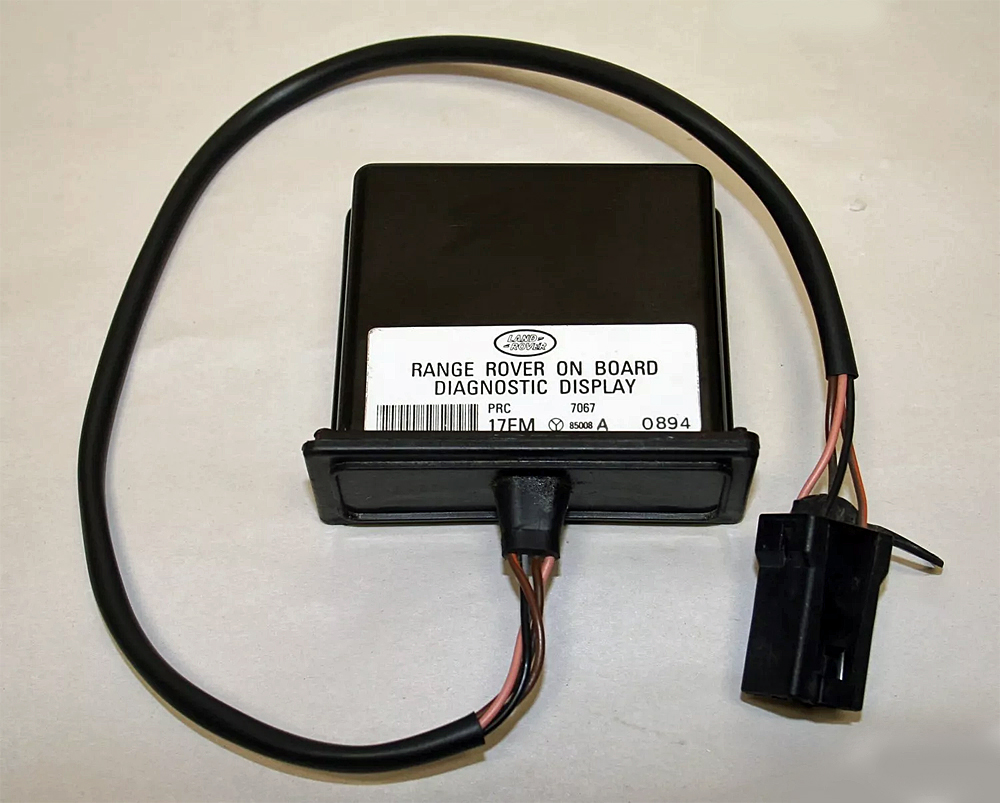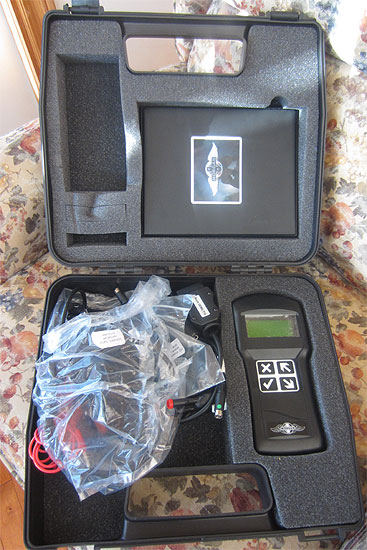 LAND
ROVER DIAGNOSTIC CODE READER (already installed with American ISIS-sourced Hotwire Plus 8s (13CU, 14CU and 14CUX) none other)
LAND
ROVER DIAGNOSTIC CODE READER (already installed with American ISIS-sourced Hotwire Plus 8s (13CU, 14CU and 14CUX) none other)
The fuel injection fault display, PART # PRC 7081 can normally be found at the rear of the glovebox on US Hotwire Plus 8s. It provides two-digit diagnostic codes in a way that's very easy to read if you know how it works (see below). The display has a dark red, transparent, molded plastic case. Light emitting diodes can be seen through the side of the case when a fault code is displayed.
If multiple faults exist, the displays them sequentially first showing the one the ECU thinks is highest priority and so on after turning the unit off and on. Higher priority faults need to be "cleared" before lower priority faults will be displayed. A blank (black) display usually indicates there are no faults..(which makes people think it is not working!). (We are not looking at common sense in any of this!) :)
Use this procedure to clear faults:
1. Switch "on" the ignition.
2. Disconnect the serial link mating plug, wait five seconds, and reconnect.
3. Switch "off" the ignition, and wait several seconds.
4. Switch "on" the ignition. The display should now reset.
December, 2024 update. Sorry for the delay. I tend to primarily focus most on stock Morgans rather than the various variants found elsewhere and all their minutiae. These super useful, bespoke diagnostic units were installed on all North American Spec (NAS) Land Rover (Disco, RR, Defender 1990-1995) vehicles by law. The late and dearly missed Bill Fink did so on his 14CUX Plus 8, stuffed behind the glove box. The RRs had them under the passenger seats.
by Lorne Goldman
The early unit of these was quite flexible. It can read (and reset) all readable Morgan EFI systems until 2004. Only a few were made. It comes with a close-to-incomprehensible manual (sad smile) and all plugs to interface with old relevant models using Ford, Rover or Land Rover or BMW.
| Note: It should then either show a lower priority fault code or appear dark. |
|
|
|
ACTION |
| Nothing shown on display | Either nothing is wrong (most likely) or the display is broken | |
| 2 | Power interruption | This code means power to the ECU has been disconnected and the car has not yet been started. This code should go away as soon as the vehicle is started for the first time. Appearance of this code while driving may signal a problem within the ECU. |
| 12 | mass airflow sensor | Usually signals a problem with the airflow meter or the connector which can fall apart or become damaged. Use correct continuity test procedure. TEST |
|
|
|
TEST |
|
|
|
TEST |
|
|
|
Usually indicates a problem. Refer to the correct continuity tests TEST |
|
|
|
Usually indicates a problem. Refer to the correct continuity tests TEST |
|
|
low throttle position reading vs. a high mass airflow readout | Usually indicates a problem. Refer to the correct continuity tests TEST |
|
|
|
Identifies that the tune resistor is open circuit-refer to tune resistor test. The tune resistor is embedded in the wire harness. This code may indicate it is damaged. TEST |
|
|
|
Check fuel system pressure and the appropriate continuity test.TEST |
| 25 | Ignition misfire | This code indicates that an ignition system misfire has been detected. Codes 40 or 50 indicate on which bank the misfire has occurred. |
|
|
|
One way to check for
small leaks is by spraying choke cleaner (aka ether) at the joint you want
to check while the motor is idling. A change in tone indicates the choke
cleaner is being sucked into the engine. Check for air leaks in the following
areas:
Hose, air flow meter to plenum
|
|
|
ECM memory fault (if code 29 is showing any other codes are unreliable and must be ignored). | If this code appears
all other faults are unreliable and must be ignored. Use the procedure
below to clear the code and see if it re-appears. If it does, your ECU
is almost certainly bad.
Procedure: leave battery connected switch ignition off wait for approximately 5 seconds disconnect ECU plug. reconnect ECU plug switch ignition on and check display unit. If fault code 29 is detected again, swap out the ECU for another and retest. |
|
|
left bank injector fault | The display will indicate
if the injector(s) are causing the engine to run rich or lean.
If the bank is running rich, check for - faulty injector wiring and connectors, stuck open injectors. If the bank is running lean, check for - faulty injector wiring and connectors, blocked injectors. TEST |
|
|
|
As code 34, except relevant to bank A injectors. TEST |
| 40 | left bank misfire | If one fault code
40 or 50 is displayed check components applicable to the particular bank
that the misfire has occurred on:
Spark plugs
If both codes are displayed, check the following components common to both banks:
Distributor cap
|
|
|
|
If one of these fault
codes (#44 or #45) is displayed check the wiring to that particular lambda
sensor. In addition this fault will be displayed if the vehicle has a condition
which causes it to run very lean or very rich on one side (example - a
vacuum leak or a bad injector). This code often appears in conjunction
with the misfire codes in cases of bad ignition misfire (cross-firing plug
wires)
If both codes are displayed, the voltage supply to the heater coils of the sensors must be checked. Check for 12V appearing on the O2 signal lead, and check the heater circuit for shorts. TEST |
|
|
|
If one of these fault
codes (#44 or #45) is displayed check the wiring to that particular lambda
sensor. In addition this fault will be displayed if the vehicle has a condition
which causes it to run very lean or very rich on one side (example - a
vacuum leak or a bad injector). This code often appears in conjunction
with the misfire codes in cases of bad ignition misfire (cross-firing plug
wires)
If both codes are displayed, the voltage supply to the heater coils of the sensors must be checked. Check for 12V appearing on the O2 signal lead, and check the heater circuit for shorts. TEST |
|
|
|
TEST |
|
|
|
If one fault code 40
or 50 is displayed check components applicable to the particular bank that
the misfire has occurred on:
Spark plugs
If both codes are displayed, check the following components common to both banks:
Distributor cap
|
| 58 | Group faults 23/28 | This indicates that a fault has been registered that is caused by the fuel supply or an air leak but the exact fault cannot be identified. Check all items outlined under codes 23 and 28. |
|
|
|
TEST |
|
|
|
TEST |
|
|
|
Refer to test 9 and 10 of the continuity test procedure. TEST |